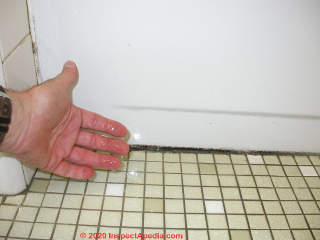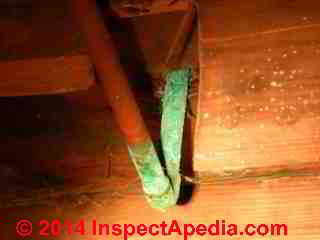 Detect & Find Plumbing Leaks
Detect & Find Plumbing Leaks
Plumbing Leak Detection Methods
- POST a QUESTION or COMMENT about types of leaks in supply & drain piping
Methods for detecting and finding the source of leaks in water supply or drain piping:
This article series describes the different types of plumbing leaks that can occur in building supply piping or drain piping.
When where, why, and how to find water supply and drain leaks.
Watch out: a water supply leak, left un-attended, can cause catastrophic damage to a building, wetting floors, walls, ceilings, and even small chronic leaks can cause expensive mold contamination in building ceilings, walls, floors.
InspectAPedia tolerates no conflicts of interest. We have no relationship with advertisers, products, or services discussed at this website.
- Daniel Friedman, Publisher/Editor/Author - See WHO ARE WE?
Water Supply & Drain Pipe Leak Detection
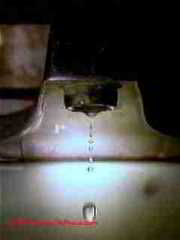 Here we combine general guidance on finding plumbing leaks in buildings, listing methods for detecting leaks in the building water supply system (pipes, valves, fixtures) and then for detecting leaks in the building drain-waste-vent system.
Here we combine general guidance on finding plumbing leaks in buildings, listing methods for detecting leaks in the building water supply system (pipes, valves, fixtures) and then for detecting leaks in the building drain-waste-vent system.
We describe approaches to finding leaks in water supply piping, followed by a similar list of techniques for finding building drain system leaks, and we provide a companion article that lists plumbing leak detection devices including leak detection tools and devices that can monitor and shut off water supply piping if a leak is detected.
If you already know that your plumbing leak is in water supply piping or at a valve or faucet or control,
see LEAK TYPES, WATER SUPPLY or DRAIN PIPES
[Click to enlarge any image]
Plumbing & Water Supply Leak Detection Methods
You may detect a leak in building supply piping either directly, by observing water or a wet spot that is traced to a leak in the supply piping system or indirectly by observing a noise (pump cycling for no reason, dripping sounds), smell (moldy wet materials), or even simply a slow loss of water pressure at a pressure tank when no water is being used.
Examples of supply piping leak detection methods are listed below, followed by a list of water supply system leak detection tools, equipment, devices.
- Intermittent water pump cycling:
if your building water is supplied by a private pump and well system or by a municipal water supply system that also incorporates a water pressure booster pump, AND if that pump is observed to occasionally turn on when, as far as you know, no water is being used in the building, THEN a common cause of that is a slow water leak somewhere in the water supply system.
The most-common causes of this symptom are a running toilet or a leaky check valve or foot valve.
See details at INTERMITTENT CYCLING WATER PUMPS - Leak noise detection:
leaks can result in dripping sounds or the sound of water running in drain pipes when we think no water is being used in the building.
A sophisticated leak detector that uses noise amplification is included
at PLUMBING LEAK DETECTION & SHUTOFF DEVICES
If you hear the sound of running water in water supply piping
and if you have turned off all plumbing fixtures that would normally use water, then there is probably a leak somewhere in the water piping system. That leak maybe inside or outside the building, as water flow noises are transmitted easily in metal and even some plastic water piping systems. - Municipal or "city" water supply system piping leaks:
between the public or community water main and the building may show up as a wet area or a muddy area in the soil near the home and along the pathway of the supply lateral pipe (water main to building), or even as wet areas in the building if the leak is outside but near the building foundation wall. - Odor detection:
even when there are no visible leaks, we may smell sewage or mold, both of which can point to plumbing leaks.
If leaks wet common building materials such as drywall, plaster, insulation, wood framing, that condition invites mold growth. Some but not all molds, under varying conditions, produce MVOCs - a musty moldy odor that is unmistakable to most people.
See HIDDEN MOLD, HOW TO FIND
Also see PLUMBING LEAKS: SEWER LINE LEAKS & ODORS - Plumbing Fixture movement:
a loose sink, a loose or wobbly toilet, even a poorly-supported shower pan can all lead to drain leaks as well as supply pipe leaks. - Septic system checks:
Leaks in the supply system such as an un-noticed running toilet can flood the septic system. If you see wet areas around the septic tank or drainfield the septic system may have failed OR there could simply be a running toilet in the building.
Watch out: water use by a running toilet can be subtle and hard to spot if the toilet's leak is a slow one. Toilet tanks can leak into the bowl at a rate too slow to be visually obvious: from tank mounting bolts or from the flush valve. But it's easy to detect a running toilet using a bit of septic dye.
See SEPTIC LOADING & DYE TEST PROCEDURE - home - Structural movement:
leaks include leaks at either drain or supply piping that was moved or dislocated by movement in the building structure.
Structural movement may be gradual such as sagging due to poor framing or rot, or it may of course be dramatic such as following an earthquake or the effects of nearby blasting. - Supply piping leak detecting tools & automatic water shutoff valves:
Include water flow monitoring equipment or water pumps that in turn incorporate water system flow monitoring in order to shut off the water supply or to sound an alarm when leak conditions are sensed.
See PLUMBING LEAK DETECTION & SHUTOFF DEVICES
A nice example of a water pump that can detect drips or leaks or abnormal continuous water use is the Scala 2 water pump described at
WATER PUMP VARIABLE FREQUENCY / VARIABLE SPEED DRIVE (VFDs)
These pumps can detect a slow but long-running or continuous use of water - characteristic of a leak or of a running toilet. - Visual inspection:
look for wet spots, dark spots, or discoloration on building walls, ceilings, floors, using the examples below, inspect the building for visual evidence of leaks, such as stains or wet spots.
At or below wet areas observed in a wall, ceiling, or above a wet area observed on a floor, look for leaks at nearby plumbing control valves as well as in the piping or pipe connections themselves.
Since a wet spot can equally be caused by a drain system leak, see
also PLUMBING DRAIN SYSTEM LEAK DETECTION below: some of the clues such as noises or wet areas can be due to either a supply piping or drain piping leak.
Invasive inspection for hidden leaks: we may cut test openings at the highest-risk or most-suspect locations to look further for leaks such as below a toilet or into a ceiling where water stains are present.
See TEST CUTS for SAMPLING BUILDING MATERIALS for some easy methods for checking in building cavities - Water meters might indicate a supply system leak:
A traditional municipal water meter will not indicate a leak on the municipal supply side of the meter as that's ahead of the meter's flow detection, but a water meter that is showing an increase or unusual level of water usage may be telling us of a leak on the building side of the meter.
Watch the water meter: if the meter is indicating water use and you have turned off all of the plumbing fixtures in your home then there is a leak somewhere.
Watch out: don't forget to check the status equipment that may be using water and that you've left on such as the automatic water feeder on a steam boiler or a washing machine or a lawn sprinkler or irrigation system. - Well piping leaks,
found anywhere on the well-side of the water pressure tank or water inlet to a building served by a private pump and well system may show up as intermittent pump cycling, drops in water pressure, low water pressure, or no water pressure in the building, depending on the severity of leakage.
See WELL PIPING LEAK DIAGNOSIS
Plumbing Drain System Leak Detection Methods
Question: how do I check for leaks at shower and toilet drains?
2020/11/10 B Schultz asked:
How do I check a toilet and the shower drains for leaks?
This Q&A were posted originally
at PLUMBING SYSTEM INSPECT DIAGNOSE REPAIR
Moderator reply: How to detect leaks in drains and traps
Mr/s Schultz
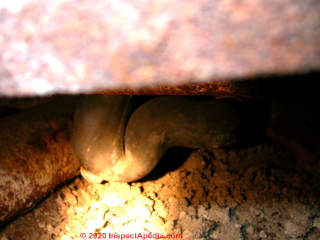 Thank you for a helpful question:
Thank you for a helpful question:
Indeed a leak at a sink trap is usually easy to see: just look under the sink for water or drips.
But a leak at a toilet or shower drain is more difficult to detect since both the toilet drain and the shower or tub trap is usually underneath a floor and not visible unless that floor is over an un-finished crawl space or basement ceiling.
Our photo shows the trap on a shower drain - a plumbing trap that is usually not visible without cutting a hole in a ceiling or as in this case, gaining access below the concrete slab into which this shower drain had been placed.
Understanding what's going on with a pipe leak can help avoid making matters worse as well as help directing the repair.
Does the leak appear regardless of whether water is being run in the building or not? If so look for a leak in supply piping or a leak at a plumbing fixture faucet or shutoff valve.
Does the leak appear only when fixtures have been in use for a while? If so look for a slow leak at building drains or at a shower pan. But also look for leaks at the tub or shower controls as some controls may leak only when the control is "on".
How to Look for Shower, Tub, or Toilet Drain Leaks
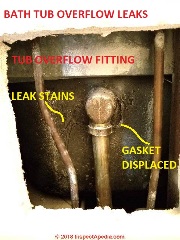 We use a combination of the following to look for plumbing leaks in buildings:
We use a combination of the following to look for plumbing leaks in buildings:
- Building leak history:
what prior leaks have been found or leak repairs have been performed. Check for recurrence of trouble at those spots. Other work on a building can be an indirect cause of leaks: roofing problems or even mechanical disturbance that damages water or supply piping - Visual inspection:
using the examples below, inspect the building for visual evidence of leaks, such as stains or wet spots.
If there is a plumbing access panel that gives view of the shower or tub controls often you can also get a (usually limited) view of the area around the tub drain and occasionally around a shower drain. - Moisture detection:
we may test or probe suspect areas such as ceilings below a bathroom for signs of moisture.
See details
at MOISTURE METER STUDY - how to use a moisture meter to check for leaks - Leak noise detection:
leaks can result in dripping sounds or the sound of water running in drain pipes when we think no water is being used in the building. - Leak odor detection:
even when there are no visible leaks, we may smell sewage or mold, both of which can point to plumbing leaks
Also see PLUMBING LEAKS: SEWER LINE LEAKS & ODORS - Fixture movement:
a loose sink, a loose or wobbly toilet, even a poorly-supported shower pan can all lead to drain leaks as well as supply pipe leaks. - Structural movement:
leaks include leaks at either drain or supply piping that was moved or dislocated by movement in the building structure.
Structural movement may be gradual such as sagging due to poor framing or rot, or it may of course be dramatic such as following an earthquake or the effects of nearby blasting. - Invasive inspection for hidden leaks:
we may cut test openings at the highest-risk or most-suspect locations to look further for leaks such as below a toilet or into a ceiling where water stains are present. - Test piping systems for leaks:
using a combination of temporary plugs in the drain/waste/vent system and air pressure, your plumber can test your piping system for leaks that include both water leaks and air or sewer gas leaks.
See details
at PLUMBING SYSTEM PRESSURE TESTS - detect leaks in supply, drain, waste or vent piping - Leak concepts help point to leak sources:
Different types of leaks require different detection methods.
Leaks that drip all the time (from supply pipes or valves) will eventually show up as a wet area somewhere in or under a building while other leaks are evident only when a fixture is in use (drains such as at toilets and showers).
Understanding the types of water leaks that occur in building piping can help you find or watch out for leaks that are not so obvious when water is first turned on in a building. - Other building leaks:
Don't assume that leaks near plumbing fixtures are only ever due to the plumbing system. These are by no means all of the building leaks that can occur, and wet areas or water damage in a building can be from many other causes than defects in building supply or drain piping. Examples are in
the RECOMMENDED ARTICLES at the end of this page. - Also see PLUMBING SUPPLY PIPING LEAK DETECTION because some plumbing system leak symptoms such as noises, odors, wet spots can be caused by either a supply piping or a drain piping leak.
Signs of Shower, Tub, or Toilet Drain Leaks
- Wet spots on the surrounding floor,
such as at a toilet base or shower pan edge.
See LEAKY TOILET SEALS, ODORS - Wet spots or stains in the ceiling
below the toilet or shower; You may see a water stain in drywall or plaster ceilings or even in nearby walls as water from a leaky toilet or tub or shower drain can also run across a ceiling and down a wall cavity;
In a basement or crawl space you may see wet insulation, subfloor, framing, or by removing insulation (if present) in the ceiling below the toilet, tub, or shower, you can inspect the floors below the toilet or shower, looking for wet areas, water damage, water stains, even insect damage as dampness can attract carpenter ants.
Note that because water an travel across a ceiling and down a wall, don't neglect inspection of building walls for leak stains or high moisture. - Odors,
such as mold smells or sewage odors. See details
at SEWER LINE LEAKS & ODORS inspectapedia.com/plumbing/Sewer_Line_Leaks.php - Visible signs of mold growth:
mushrooms or mold appearing on nearby building surfaces - Moisture measurement:
using a pin type or electronic type moisture meter, measure the surrounding floor and the ceiling below the toilet or shower for signs of higher levels of moisture than in other ceilings (or walls) nearby. See
MOISTURE METER STUDY for a guide to using a moisture meter reliably; that article includes a link
to MOISTURE METER SOURCES
At our Continue Reading link just below we continue with a listing of leak detection advices that can sound an alarm, send you a notice by smartphone email or text, and that can, for some devices, actually automatically turn off water to a leaking or dripping fixture or can shut off water to the entire building if a leak is detected.
...
Continue reading at PLUMBING LEAK DETECTION & SHUTOFF DEVICES, or select a topic from the closely-related articles below, or see the complete ARTICLE INDEX.
Or see these
Recommended Articles
- DIAGNOSE CLOGGED DRAINS
- DRAIN PIPE LEAK TYPES
- DRIPPING WATER SOUND SOURCES
- FAUCETS & CONTROLS, KITCHEN & BATH
- HIDDEN MOLD, HOW TO FIND
- INTERMITTENT CYCLING WATER PUMPS
- LEAK CAUSES in WATER PIPING - what causes leaks in metal piping?
- LEAK TYPES, WATER SUPPLY or DRAIN PIPES
- LEAKY TOILET SEALS, ODORS
- MOISTURE METER STUDY - how to use a moisture meter to check for leaks
- PLUMBING FIXTURE TRAPS
- PLUMBING LEAK DETECTION METHODS
- PLUMBING LEAK DETECTION & SHUTOFF DEVICES
- PLUMBING LEAKS: SEWER LINE LEAKS & ODORS
- PLUMBING SYSTEM PRESSURE TESTS - detect leaks in supply, drain, waste or vent piping
- REPAIR BURST LEAKY PIPES
- SEPTIC LOADING & DYE TEST PROCEDURE
- SEWER GAS TESTS & DETECTION
- SEWER LINE LEAKS & ODORS
- SWIMMING POOL LEAK DETECTION
- THAWING FROZEN PIPES how to find frozen and burst pipe leaks in buildings without causing a catastrophe
- THERMAL IMAGING, THERMOGRAPHY - can detect active plumbing leaks (or other heat loss)
- WALL / WINDOW LEAK DIAGNOSIS
- WATER ENTRY in BUILDINGS - home
- WELL PIPING LEAK DIAGNOSIS - how to figure out if there is a leak in the well piping system
Suggested citation for this web page
PLUMBING LEAK DETECTION METHODS at InspectApedia.com - online encyclopedia of building & environmental inspection, testing, diagnosis, repair, & problem prevention advice.
Or see this
INDEX to RELATED ARTICLES: ARTICLE INDEX to PLUMBING SYSTEMS
Or use the SEARCH BOX found below to Ask a Question or Search InspectApedia
Ask a Question or Search InspectApedia
Try the search box just below, or if you prefer, post a question or comment in the Comments box below and we will respond promptly.
Search the InspectApedia website
Note: appearance of your Comment below may be delayed: if your comment contains an image, photograph, web link, or text that looks to the software as if it might be a web link, your posting will appear after it has been approved by a moderator. Apologies for the delay.
Only one image can be added per comment but you can post as many comments, and therefore images, as you like.
You will not receive a notification when a response to your question has been posted.
Please bookmark this page to make it easy for you to check back for our response.
IF above you see "Comment Form is loading comments..." then COMMENT BOX - countable.ca / bawkbox.com IS NOT WORKING.
In any case you are welcome to send an email directly to us at InspectApedia.com at editor@inspectApedia.com
We'll reply to you directly. Please help us help you by noting, in your email, the URL of the InspectApedia page where you wanted to comment.
Citations & References
In addition to any citations in the article above, a full list is available on request.
- Mark Cramer Inspection Services Mark Cramer, Tampa Florida, Mr. Cramer is a past president of ASHI, the American Society of Home Inspectors and is a Florida home inspector and home inspection educator. Mr. Cramer serves on the ASHI Home Inspection Standards. Contact Mark Cramer at: 727-595-4211 mark@BestTampaInspector.com
- John Cranor [Website: /www.house-whisperer.com ] is an ASHI member and a home inspector (The House Whisperer) is located in Glen Allen, VA 23060. He is also a contributor to InspectApedia.com in several technical areas such as plumbing and appliances (dryer vents). Contact Mr. Cranor at 804-873-8534 or by Email: johncranor@verizon.net
- In addition to citations & references found in this article, see the research citations given at the end of the related articles found at our suggested
CONTINUE READING or RECOMMENDED ARTICLES.
- Carson, Dunlop & Associates Ltd., 120 Carlton Street Suite 407, Toronto ON M5A 4K2. Tel: (416) 964-9415 1-800-268-7070 Email: info@carsondunlop.com. Alan Carson is a past president of ASHI, the American Society of Home Inspectors.
Thanks to Alan Carson and Bob Dunlop, for permission for InspectAPedia to use text excerpts from The HOME REFERENCE BOOK - the Encyclopedia of Homes and to use illustrations from The ILLUSTRATED HOME .
Carson Dunlop Associates provides extensive home inspection education and report writing material. In gratitude we provide links to tsome Carson Dunlop Associates products and services.


